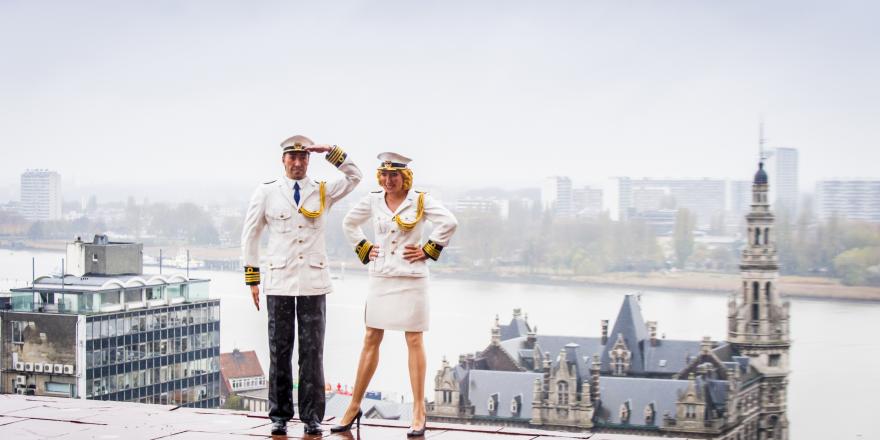For this artwork, Guillaume Bijl was inspired by the area of the port with its multitude of (cruise) ships. The Saluting Admiral Couple appears to have become lost during a walk around the city and have accidently landed upon the shoulder of the MAS. Passers by can see the couple out on the 8th floor from below.
- Saluting Admiral Couple, 2016 (unique work)
- Figurative, two human figures. (height 185 cm and 175 cm)
- Approximate weight: 100 kg per figure
- Painted bronze
Artwork on the shoulder of the MAS
Ever since the concept phase of the MAS, it was the wish of Neutelings Riedijk Architects to realise art integration. The ‘shoulder’ of the MAS on the 8th floor – a cove in the architecture next to the promenade – was the perfect place for this artwork.
Alderman for Culture, Philip Heylen: “The MAS architecture is strong, robust and serious. The tongue-in-cheek work by Guillaume Bijl gives it a playful and suprising element. Along with Dead Skull by Luc Tuymans – the mosaic floor on the courtyard of the MAS – the museum now has two high profile art integrations by internationally renowned Antwerp artists.”
Art in the public space
The shoulder of the MAS is a part of the so-called promenade, the glass spiral along the galleries leading to the tenth floor via escalators. This part of the building is a public space. The city of Antwerp asked Guillaume Bijl to create an artwork for this location.
The art integration was advised by the committee of statues in the city. The committee is chaired by the coordinator of art policy in the city of Antwerp and consists of a mix urban officials and external artistic advisers who provide technical advice on licensing, safety, technical conditions and other legal obligations. They advise the Board of Mayo rand Aldermen about art in public spaces. Contemporary art integration in the urban public space is a clear policiy option within the urban art policy. Through this process, the bronze statue Pliny’s Sorrow by artist Johan Creten recently recieved a permenant position on the Rijnkaai.
The Middelheim museum guided the project (with their expertise on outdoor art and the realisation of art commissions), including the selection of an artist and the proposal (from his role in the committee of statues in the city) and was responsible for the mediation between the artist and the client (Antwerp / MAS) as well as the production process and installation. Middelheim museum are also responsible for the after-care and maintenance of the artwork.
About Guillaume Bijl
Guillaume Bijl (°1946) is an Antwerp artist with an impressive international career. After his notable debut exhibition in 1979 (Driving Z arena Z), he broke through interntionally (1988 Belgian Pavilion Venice Biënnale, 1922 Documenta 9, Kassel, 1992 Biënnale Sydney; 1993 Biënnale Lyon; 2007 Sculpture Project Kassel; 2016 Manifesta Zürich). His installations can be seen all over the world. From 2001 to 2011 he was the professor of sculpture at the art academy Münster. In 2012 he won the quadrennial oeuvre art prize from the City of Antwerp. He is concerned with the fate of aspiring artists, and is one of the driving forces behind the artists organisation NICC vzw.
For more than 30 years, Guillaume Bijl has been transforming museum spaces and art galleries such as Driving (1979), an Atomic Bomb Shelter (1985), a Stemhokkenmuseum – voting station (2000), and a Mattress Discount (2003). In these three-dimensional still lives, there is not usually a precise reconstruction of the subject, but a stereotype. Bijl’s artistic form is so realistic that the viewer can often not tell if it is fiction or reality. This creates a moment of alienation. It exposes our leisure and consumerism as an empty decor culture.
The artist recently begun to make figurative sculptures. They are artisan made and manufactured in bronze or aluminium. Just look at his image Festive Series (2014) on the Europaplein at the Rai (Zuidas Amsterdam), or Ein neuer erfolgreicher Tag (2008) in Wüppertal (Germany).



